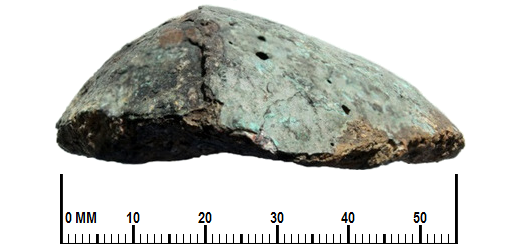
about ancient nomos
Ancient Nomos Art is a museum of galleries exhibiting ancient coins and ancient mint maps. The coin gallery displays the diverse art and history of hand-crafted ancient Greek, Roman, Byzantine, Persian and Medieval coinage. The ancient mints mapping gallery features Greek, Roman, Byzantine, Asia Minor and Medieval mint city regions and territories. Visitor's are welcome to explore, study and enjoy Ancient Nomos Art.

Roman Aes Formatum Ingot
6th-4th Century BC
From Ancient Galleries

Obverse: Aes Formatum circular dome-shaped bronze ingot with central casting seam.
Reverse: Aes Formatum planar surface and blank.
 DESCRIPTION
DESCRIPTION
Obv: Aes Formatum circular dome-shaped bronze ingot with central casting seam. Rev: Planar surface and blank.
The vast archaeological evidence for the archaic Roman copper-age and bronze-age history exists in many sites throughout the central Umbria regions and beyond. Prior to the Roman archaic bronze history was a primitive pre-phase “natural” agrarian economy, where goods and services were simply bartered in order to exchange. To better facilitate trade, an archaic copper and bronze monetary economy was employed to simplify transactions, sometime between the 6th – 4th centuries BC. During this time, aes formatum bronze ingots and round specimen types (as depicted above), have been discovered throughout the central Italian peninsula including in Aria, Cervetari, Cere and Etruria. Even as far away as the town of Porto Torres on the island of Sardinia, evidence of a highly developed bronze metalworking industry has disclosed many extant finds of bronze ingots, copper fragments, molds and other bronze artifacts. This new and burgeoning archaic Roman copper and bronze economy refined and weighted these metals based on the already existing barter trade values for a head of cattle, oxen and sheep, long established during the primitive pre-phase “natural” economy. As the bronze trade gradually became more and more refined (weighed metal and therefore money), the system of exchange could easily convert staples like oxen, sheep and other agricultural goods into a copper of bronze equivalence in weight. The vast extent and wide range of aes formatum finds clearly demonstrates the growing importance and high value these metals played, eventually becoming interconnected between the ancient Romans and other cultures beyond the Mediterranean. As the bronze economy expanded, the category of cattle and oxen no longer performed the function of measuring one’s wealth. Instead, copper and bronze emerged as a qualitative and quantitative measure of value and of one’s wealth. The above one libra (one pound) bronze aes formatum ingot is an extremely rare, unusual and fascinating “as made” ingot specimen and exhibits a deep olive green patina, with turquoise highlights over domed surfaces. The “reverse” planar side still contains residual casting clay mold deposits along with several areas of green patina. Compared to the previous five libra aes formatum ingot, this piece is a relatively small one libra specimen and weights only 273 grams (see 5 Libra Aes Formatum). These fascinating copper based ingots became established monetary currency following a historic mid-fifth century BCE trip the Romans made to Athens to study Athenian laws. The trip became a “lessons learned” event that transformed the Roman economy. In 454 BC, the Roman’s developed the Lex Aternia-Tarpeia, a.k.a. “Tarpeian Law” which replaced livestock as money with a newly codified copper by weight economic standard. In part, the law defined a libra weight of copper as an As. The Roman Republican era As began as a libra of just over 300 grams of copper. By 451 BC, the archaic Republican bronze-age period formally enacted exchange laws found in the Law of the Twelve Tables (A. Gaius, Institutes, Book I, 122), stipulating refined and carefully weighed bronze (copper plus tin) was to be used as the only commodity equivalent and instrument of economic exchange in Rome. The new exchange laws valued an ox at 100 asses and valued sheep at 10 asses, in other words, 1 oxen had the same value as 10 sheep.
DOCUMENTATION
Value: 1 As. Metal: Æ cast bronze. Weight: 273 grams. Roman libral standard. Dated: 5th-4th century BC.
Attribution: Italo Vecchi. Italian Cast Coinage. London. 2013; Haeberlin, Aes Grave; Das Schwergeld Rom und Mittelitaliens, plate 2, #7-8; Lex Aternia-Tarpeia Libra from A. Gaius, Institutes, Book I, 122 (premonetale).
AES FORMATUM INGOT EDGE VIEW

SPECIAL FEATURE EXHIBIT
The ANAM Special Features gallery presents the results of energy-dispersive X-ray spectroscopy (EDS, also abbreviated EDX or XEDS) analytical equipment and software techniques to enable the chemical characterization and elemental analysis of this ancient Roman dome-shaped aes formatum cast bronze ingot. To view the Republican Roman Aes Formatum chemical characterization and elemental analysis study in the Special Features gallery, please use the following link: Roman Aes Formatum Study Special Features Exhibit
Legend, Documentation and Attribution
